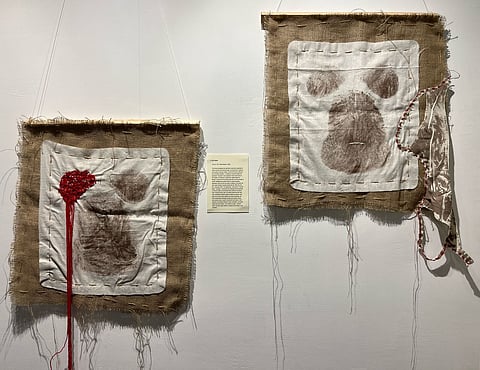

In the 2025 film Sinners, Annie (played by Wunmi Mosaku) challenges beauty standards as a plus-sized, dark-skinned Black woman. Smoke (Michael B Jordan) stands beside her as an equally layered partner. Critics praised Wunmi Mosaku’s performance for giving voice to a rarely seen character, but Sinners also showed how rare such representation still is.
In Indian context too, from films to cartoons to fiction, pop culture often reflects a certaingaze — reinforcing caste hierarchies and colourism. AN Yazhini, a city-based visual artist, uses her work to resist systems that decide whose bodies are celebrated and whose are ignored.
One of her pieces, 'Dark or Divine', is a bold acrylic triptych that explores how skin tone is shown in religion and pop culture. “I was moved by how Amman from marginalised communities is represented,” Yazhini says. “I always noticed that in representations of gods or divine figures, dark-skinned ones are rare or misrepresented.” She adds, “The savarna gaze has contributed to this shift in depiction — from dark skin tones to fair or pink ones, erasing their original identities.”
In older myths, Krishna and Kali were described as dark-skinned — their very names mean “dark” or “the dark one.” “Why should fair skin be considered divine? Why is dark not divine?” Yazhini asks.
Protests in paintings
Besides 'Dark or Divine', is a mixed-media work made of jute (koni pai cloth), yarn thread, and a body print. In this piece, Yazhini connects two protests that happened a century apart in different parts of the world.
One is the Thol Seelai Porattam, the so-called “breast tax” protest. In 19th-century Travancore, Nangeli, a lowered-caste Ezhava woman, cut off her breasts in protest against a tax that forced women like her to pay for the right to cover their chests. The other is a series of Western feminist protests: the 1968 “Burn the Bra” demonstration, 2007’s “Go Topless Day”, and the 2012 “Free the Nipple” campaign.
Lived experiences
“People often view feminism through a very narrow lens and say one is true feminism and the other is pseudo feminism,” she explains. “The Thol Seelai Porattam was a protest for the right to wear upper garments by women from marginalised communities, while the Free the Nipple and Burn the Bra movements are often misunderstood as the right to not wear upper garments. Both are about bodily autonomy.”
Born and raised in Chennai, Yazhini began her art journey in higher secondary school. She explored photography, dance, and theatre, but later chose visual art. After completing a BFA at the Government College of Fine Arts, Chennai, she finished her Master’s in Visual Art at Ambedkar University, Delhi, in 2024. Her work is shaped by her lived experience as a dark-skinned Bahujan woman in India. “I’ve always received criticism about my body — like other women — not being represented or being misrepresented in mainstream media. These things led me to create politically. Everything I produce comes from or is related to my skin and body,” she says. On her goals for Dark or Divine, she shares, “A seventh-grade girl once asked me about it after seeing my interview, and that made me feel that my goal was working. Conversations like these need to happen in various spaces.”
But for Yazhini, representation means more than just being visible. It must also challenge internalised bias. When asked whether mainstream Indian feminism adequately addresses caste, Yazhini is unequivocal. “Definitely not. There is a lack of intersectionality.” She expands, “In feminist discourses, it’s not very intersectional. They don’t talk about caste. And in caste discourses, they don’t talk about feminism. I want to give an example for that by stating the ongoing discussions with rapper Vedan. How he is a Dalit rapper and how he is being cornered right now. But people don’t acknowledge the fact that he has been accused of
#MeToo, and is a sexual harasser.”
Aware of online censorship, especially on political topics, she prefers the openness of exhibitions and festivals.
She is also wary of the hype around AI in art-making, citing its lack of emotional authenticity. “AI is often inaccurate. It doesn’t understand the emotional or lived aspects — it’s all about prompts.”
The artist is currently doing an indepth research on the Thol Seelai Porattam, and also exploring new formats such as sculpture, installation, and performance. “I’m interested in pushing beyond the canvas,” she says.
For her, art is not a luxury but a necessity — a way to survive, to be seen, and to push back against erasure. Through her work, she invites viewers to reject neat, sanitised versions of divinity and feminism — and instead embrace the messy, complex truth.